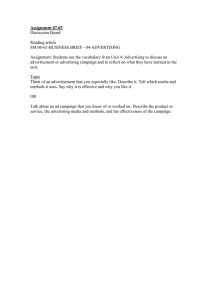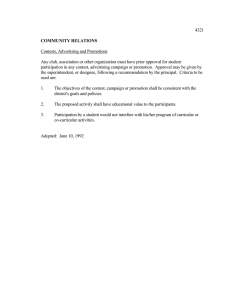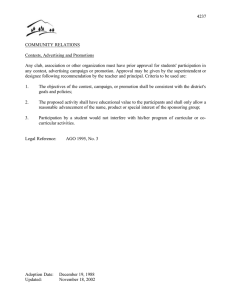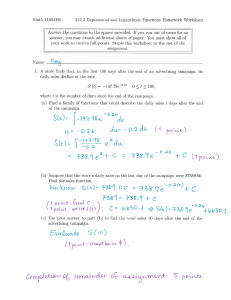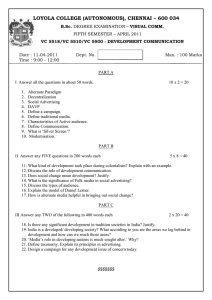advertising campaign
advertisement
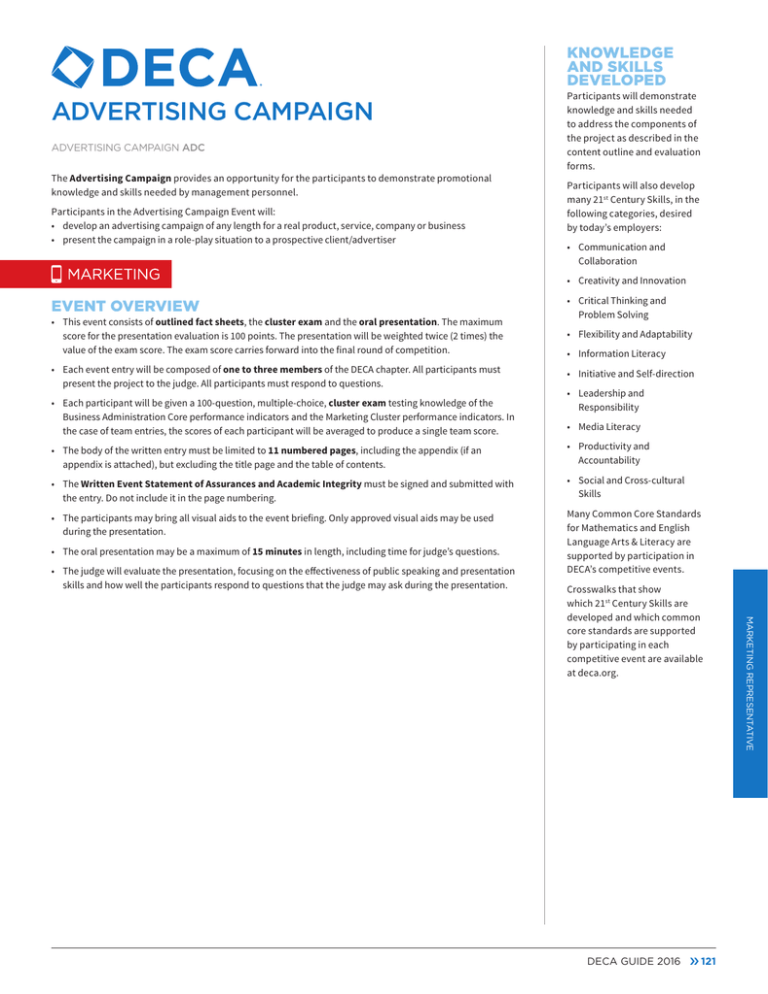
KNOWLEDGE AND SKILLS DEVELOPED ADVERTISING CAMPAIGN ADVERTISING CAMPAIGN ADC The Advertising Campaign provides an opportunity for the participants to demonstrate promotional knowledge and skills needed by management personnel. Participants in the Advertising Campaign Event will: • develop an advertising campaign of any length for a real product, service, company or business • present the campaign in a role-play situation to a prospective client/advertiser Participants will demonstrate knowledge and skills needed to address the components of the project as described in the content outline and evaluation forms. Participants will also develop many 21st Century Skills, in the following categories, desired by today’s employers: • Communication and Collaboration • Creativity and Innovation EVENT OVERVIEW • This event consists of outlined fact sheets, the cluster exam and the oral presentation. The maximum score for the presentation evaluation is 100 points. The presentation will be weighted twice (2 times) the value of the exam score. The exam score carries forward into the final round of competition. • Each event entry will be composed of one to three members of the DECA chapter. All participants must present the project to the judge. All participants must respond to questions. • Each participant will be given a 100-question, multiple-choice, cluster exam testing knowledge of the Business Administration Core performance indicators and the Marketing Cluster performance indicators. In the case of team entries, the scores of each participant will be averaged to produce a single team score. • Critical Thinking and Problem Solving • Flexibility and Adaptability • Information Literacy • Initiative and Self-direction • Leadership and Responsibility • Media Literacy • The body of the written entry must be limited to 11 numbered pages, including the appendix (if an appendix is attached), but excluding the title page and the table of contents. • Productivity and Accountability • The Written Event Statement of Assurances and Academic Integrity must be signed and submitted with the entry. Do not include it in the page numbering. • Social and Cross-cultural Skills • The participants may bring all visual aids to the event briefing. Only approved visual aids may be used during the presentation. Many Common Core Standards for Mathematics and English Language Arts & Literacy are supported by participation in DECA’s competitive events. • The oral presentation may be a maximum of 15 minutes in length, including time for judge’s questions. • The judge will evaluate the presentation, focusing on the effectiveness of public speaking and presentation skills and how well the participants respond to questions that the judge may ask during the presentation. DECA GUIDE 2016 ›› 121 MARKETING REPRESENTATIVE Crosswalks that show which 21st Century Skills are developed and which common core standards are supported by participating in each competitive event are available at deca.org. WRITTEN ENTRY GUIDELINES The written entry must follow these specifications. Refer also to the Written Entry Checklist and the Written Entry Evaluation Form. WRITTEN EVENT STATEMENT OF ASSURANCES AND ACADEMIC INTEGRITY. This must be signed and submitted with the entry. Do not include it in the page numbering. TITLE PAGE. The first page of the written entry is the title page. It must include in any order, but is not limited to, the following: ADVERTISING CAMPAIGN Name of DECA chapter Name of high school School address City, State/Province, ZIP/Postal Code Names of participants Date Title page will not be numbered. TABLE OF CONTENTS. The table of contents should follow the title page. The table of contents may be single-spaced and may be one or more pages long. The table of contents page(s) will not be numbered. BODY OF THE WRITTEN ENTRY. The body of the written entry begins with Section I, Executive Summary, and continues in the sequence outlined here. The first page of the body is numbered “1” and all following pages are numbered in sequence. Page numbers continue through the bibliography (required) and the appendix (optional). The participants will prepare Advertising Campaign fact sheets. The fact sheets, in outline form, shall be limited to a maximum of 11 pages (not including title page). This outline must be followed. Points for each section are included on the Written Entry Evaluation Form. Each section must be titled, including the bibliography and the appendix. I. EXECUTIVE SUMMARY One-page description of the campaign II. DESCRIPTION Description of the product, service, company or business selected III. OBJECTIVE(S) OF THE CAMPAIGN IV. IDENTIFICATION OF THE TARGET MARKET A. Primary markets B. Secondary markets V. LIST OF ADVERTISING MEDIA SELECTION NECESSARY FOR THE CAMPAIGN VI. SCHEDULES OF ALL ADVERTISING PLANNED VII. SCHEDULES OF ALL SALES PROMOTION ACTIVITY(IES) PLANNED VIII. BUDGET (detailed projections of actual cost) IX. STATEMENT OF BENEFITS TO THE CLIENT/ADVERTISER X. BIBLIOGRAPHY XI. APPENDIX An appendix is optional. Include in an appendix any exhibits appropriate to the written entry but not important enough to include in the body. These might include sample questionnaires used, letters sent and received, general background data, minutes of meetings, etc. 122 ›› DECA GUIDE 2016 1 to 3 PARTICIPANTS MARKETING CLUSTER EXAM PAGES ALLOWED PRESENTATION TIME WRITTEN ENTRY CHECKLIST In addition to Written Entry Guidelines, participants must observe all of the standards on the Written Entry Checklist on page 52. These standards are designed to make competition as fair as possible. PRESENTATION GUIDELINES • The major emphasis of the fact sheets is on the content. Drawings, illustrations and graphic presentations (where allowed) will be judged for clarity, not artistic value. • The participants will present to the judge in a 15-minute presentation worth 100 points. (See Presentation Judging.) • The presentation begins immediately after the introduction of the participants to the judge by the adult assistant. Each participant must take part in the presentation. • Each participant may bring a copy of the written entry or note cards pertaining to the written entry and use as reference during the presentation. • If time remains, the judge may ask questions pertaining to the project. • The participants may use the following items during the oral presentation: – not more than three (3) standard-sized posters not to exceed 22 1/2 inches by 30 1/2 inches each. Participants may use both sides of the posters, but all attachments must fit within the poster dimensions. – one (1) standard-sized presentation display board not to exceed 36 1/2 inches by 48 1/2 inches. – one (1) desktop flip chart presentation easel 12 inches by 10 inches (dimensions of the page). – one (1) personal laptop computer. – cell phones/smartphones, iPods/MP3 players, iPads/tablets or any type of a hand-held, information sharing device will be allowed in written events IF applicable to the presentation. – sound, as long as the volume is kept at a conversational level. • Only visual aids that can be easily carried to the presentation by the actual participants will be permitted, and the participants themselves must set up the visuals. No set-up time will be allowed. Participants must furnish their own materials and equipment. No electrical power or Internet connection will be supplied. • Materials appropriate to the situation may be handed to or left with judges in all competitive events. Items of monetary value may be handed to but may not be left with judges. Items such as flyers, brochures, pamphlets and business cards may be handed to or left with the judge. No food or drinks allowed. • If any of these rules are violated, the adult assistant must be notified by the judge. PRESENTATION JUDGING MARKETING REPRESENTATIVE Participants will make a 15-minute presentation to you. As the judge, you are to assume the role of a client/ advertiser who will assess the participants’ campaign proposals. You may refer to the written entry, or to your notes, during the presentation. At the beginning of the presentation (after introductions), the participants will present the proposal. Allow the participants to complete this portion without interruption, unless you are asked to respond. Each participant must take part in the presentation. If time remains, you may ask questions that seem appropriate, based on your notes or on the written entry itself (to which you may refer during the presentation). At the conclusion of the presentation, thank the participants. Then complete the Presentation Evaluation Form, making sure to record a score for all categories. The maximum score for the evaluation is 100 points. DECA GUIDE 2016 ›› 123 ADVERTISING CAMPAIGN ADVERTISING CAMPAIGN ADC FACT SHEETS AND PRESENTATION EVALUATION FORM LITTLE/ NO VALUE BELOW EXPECTATIONS MEETS EXPECTATIONS EXCEEDS EXPECTATIONS 0-1-2-3-4 5-6-7-8-9 10-11-12 13-14-15 2. The target market is clearly and accurately analyzed for the product(s) and/or service(s) selected. The secondary target markets are accurately considered. 0-1-2 3-4-5 6 7-8 3. The media selection is realistic and properly defined in terms of reach, frequency and continuity. 0-1-2 3-4-5 6 7-8 4. The budget is realistic for the campaign based on the product and location of the campaign. All costs that would be incurred have been considered. 0-1-2 3-4-5 6 7-8 5. The advertising scheduled shows continuity and logical order. 0-1-2 3-4-5 6 7-8 6. The campaign has a realistic length and promotions are scheduled properly in relation to the stated target markets. 0-1-2 3-4-5 6 7-8 7. The campaign stresses product and/or service benefits that appeal to the target markets described. 0-1-2 3-4-5 6 7-8 8. Anticipated sales are given and are realistic in terms of the length and budget of the campaign. Mentions how the results will be evaluated. 0-1-2 3-4-5 6 7-8 9. The ad layouts, commercials, etc., show a basic understanding of production techniques, are consistent with other parts of the campaign and are original. 0-1 2-3 4--5 6-7 10. The written and oral presentations show evidence of a realistic knowledge of advertising principles and are well-organized and presented in a logical manner. 0-1 2-3 4--5 6-7 11. The oral presentation clearly expands and develops the objectives as written in the fact sheets. 0-1 2-3 4--5 6-7 12. Appearance of fact sheets and word usage. Professional layout, neatness, proper grammar, spelling and word usage. 0-1 2 3 4 13. Overall performance: professional appearance, poise, confidence, presentation technique, effective use of visuals, professionalism of participants, participation by each participant present. 0-1 2 3 4 1. The oral presentation clearly expands and develops the objectives as written in the fact sheets. JUDGED SCORE TOTAL POINTS (100) LESS PENALTY POINTS TOTAL SCORE JUDGE __________ 124
